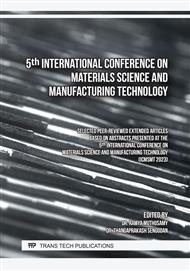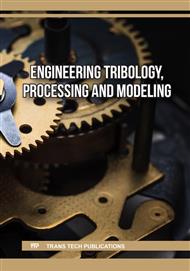[1]
R.Y. Alsada, Y. Kumar, A measurement of quality costs in industrial organizations, Cogent Business & Management, 9(1) (2022) 2128253.
DOI: 10.1080/23311975.2022.2128253
Google Scholar
[2]
H. Saranga, R. George, J. Beine, U. Arnold, Resource configurations, product development capability, and competitive advantage: An empirical analysis of their evolution, Journal of Business Research, 85 (2018) 32-50.
DOI: 10.1016/j.jbusres.2017.11.045
Google Scholar
[3]
A.B. Solanki, S.S. Sonigra, V. Vajpayee, Implementation of quality tools and effective strategies to boost production market standards for forged crankshafts: A case study of forging industry, Materials Today: Proceedings, 47(17) (2021) 5970-5976.
DOI: 10.1016/j.matpr.2021.04.537
Google Scholar
[4]
W. Zhang, G. Zhao, Q. Fu, Study on the effects and mechanisms of induction heat treatment cycles on toughness of high frequency welded pipe welds, Materials Science and Engineering: A, 736 (2018) 276-287.
DOI: 10.1016/j.msea.2018.09.004
Google Scholar
[5]
C. Cheng, K. Kadoi, S. Tokita, H. Fujii, K. Ushioda, H. Inoue, Effects of carbon and chromium on microstructure evolution and mechanical properties of friction stir weldment in medium-carbon steel, Materials Science and Engineering: A, 762 (2019) 138060.
DOI: 10.1016/j.msea.2019.138060
Google Scholar
[6]
O. Kurpe, V. Kukhar, R. Puzyr, V. Burko, E. Balalayeva, E. Klimov, Electric motors power modes at synchronization of roughing rolling stands of hot strip mill, in: Proc. 25th IEEE International Conference on Problems of Automated Electric Drive. Theory and Practice, PAEP, Kremenchuk, Ukraine, IEEE, 2020, 1-4.
DOI: 10.1109/paep49887.2020.9240818
Google Scholar
[7]
V.I. Zurnadzhy, V.G. Efremenko, K. Wu, I. Petryshynets, K. Shimizu, A.M. Zusin, M.N. Brykov, V.A. Andilakhai, Tailoring strength/ductility combination in 2.5 wt% Si-alloyed middle carbon steel produced by the two-step Q-P treatment with a prolonged partitioning stage, Materials Science and Engineering: A, 791 (2020) 139721.
DOI: 10.1016/j.msea.2020.139721
Google Scholar
[8]
V.I. Zurnadzhy, V.G. Efremenko, I. Petryshynets, K. Shimizu, M.N. Brykov, I.V. Kushchenko, V.V. Kudin, Mechanical properties of carbide-free lower bainite in complex-alloyed constructional steel: Effect of bainitizing treatment parameters, Kovove Materialy, 58 (2020) 129-140.
DOI: 10.4149/km_2020_2_129
Google Scholar
[9]
S. G. Karnaukh, O. E. Markov, V. V. Kukhar, A. A. Shapoval, Classification of steels according to their sensitivity to fracture using a synergetic model, International Journal of Advanced Manufacturing Technology, 119(7-8) (2022) 5277-5287.
DOI: 10.1007/s00170-022-08653-y
Google Scholar
[10]
O.E. Markov, O.V. Gerasimenko, V.V. Kukhar, O.R. Abdulov, N.V. Ragulina, Computational and experimental modeling of new forging ingots with a directional solidification: The relative heights of 1.1, Journal of the Brazilian Society of Mechanical Sciences and Engineering, 41(8) (2019) 1-13.
DOI: 10.1007/s40430-019-1810-z
Google Scholar
[11]
O.E. Markov, I.S. Aliiev, L.I. Aliieva, N.S. Hrudkina, Computerized and physical modeling of upsetting operation by combined dies, Journal of Chemical Technology and Metallurgy, 55(3) (2020) 640-648.
Google Scholar
[12]
Y. Gao, Y. Liu, L. Wang, X. Yang, T. Zeng, L. Sun, R. Wang, Microstructure evolution and wear resistance of laser cladded 316L stainless steel reinforced with in-situ VC-Cr7C3, Surface and Coatings Technology, 435 (2022) 128264.
DOI: 10.1016/j.surfcoat.2022.128264
Google Scholar
[13]
L.X. Li, Y.H. Wang, W.J. Wang, J.Y. Liu, Z.Q. Xu, F.S. Du, Mechanism and prediction of hydrogen embrittlement based on complex phase structure of chromium alloy steel, Materials Science and Engineering: A, 822 (2021) 141546.
DOI: 10.1016/j.msea.2021.141546
Google Scholar
[14]
D. Music, U. Kreissig, R. Mertens, J.M. Schneider, Electronic structure and mechanical properties of Cr7C3, Physics Letters A, 326(5-6) (2004) 473-476.
DOI: 10.1016/j.physleta.2004.04.068
Google Scholar
[15]
Y. Ma, M. Guo, W. Li, Y. Yang, P. Gao, Y. Cui, W. Sun, Y. Wang, L. Wang, Y. Dong, Microstructure and properties of Cr7C3-CrSi2 composite coatings prepared by plasma spraying, Surface and Coatings Technology, 412 (2021) 127011.
DOI: 10.1016/j.surfcoat.2021.127011
Google Scholar
[16]
V.V. Kukhar, Producing of elongated forgings with sharpened end by rupture with local heating of the workpiece method, Metallurgical and Mining Industry, 6 (2015) 122-132.
Google Scholar
[17]
A. Rosa-Sainz, M.L. García-Romeu, I. Ferrer, M.B. Silva, G. Centeno, On the effective peek application for customized cranio-maxillofacial prostheses: An experimental formability analysis, Journal of Manufacturing Processes, 86 (2023) 66-84.
DOI: 10.1016/j.jmapro.2022.12.044
Google Scholar
[18]
V.V. Kukhar, O.V. Vasylevskyi, Experimental research of distribution of strains and stresses in work-piece at different modes of stretch-forging with rotation in combined dies, Metallurgical and Mining Industry, 3 (2014) 71-78.
Google Scholar
[19]
X. Liu, C. Zhu, S. Sun, R.i Ma, Rotary forging with multi-cone rolls, Journal of Manufacturing Processes, 56(A) (2020) 656-666.
DOI: 10.1016/j.jmapro.2020.05.037
Google Scholar
[20]
I. Zhbankov, L. Aliieva, K. Malii, Simulation of microstructure changes of steel during the open die forging process, Journal of Chemical Technology and Metallurgy, 55(3) (2020) 523-529.
Google Scholar
[21]
J.A. Suris, C.C. Yurgel, R. Alves de Sousa, Influence of the Grain-Flow Orientation after Hot Forging Process Evaluated through Rotational Flexing Fatigue Test, Metals, 13 (2023) 187.
DOI: 10.3390/met13020187
Google Scholar
[22]
A.A. Emamverdian, Y. Sun, C. Chunping, Deformation and wear in a H21 (3Cr2W8V) steel die during hot forging: Simulation, mechanical properties, and microstructural evolution, Journal of Materials Research and Technology, 15 (2021) 268-277.
DOI: 10.1016/j.jmrt.2021.08.022
Google Scholar
[23]
T.V. Olshanskaya, A.Y. Dushina, D.N. Trushnikov, Research of the technological methods influence on the formation of structure and properties during the additive growth of products from nickel chromium steels of the austenitic class by plasma-jet hard facing methods, Journal of Physics: Conference Series, 2275 (2022) 012003.
DOI: 10.1088/1742-6596/2275/1/012003
Google Scholar
[24]
A. Feng, J. Zhao, J. Lin, X. Pan, H. Feng, C. Wang, Z. Lu, Effect of Laser Quenching-Shock Peening Strengthening on the Microstructure and Mechanical Properties of Cr12MoV Steel, Materials, 15 (2022) 6693.
DOI: 10.3390/ma15196693
Google Scholar
[25]
L. Gong, Y. Pan, C. Peng, X. Fu, Z. Jiang, S. Jiang, Effect of ultrasonic surface rolling processing on wear properties of Cr12MoV steel, Materials Today Communications, 33 (2022) 104762.
DOI: 10.1016/j.mtcomm.2022.104762
Google Scholar
[26]
H. Wang, Y. Zhai, L. Zhou, Z. Zhang, B. Liu, Analysis of Austempering Characteristics of Cr12MoV Die Steel, Journal of Physics: Conference Series, 2338 (2022) 012019.
DOI: 10.1088/1742-6596/2338/1/012019
Google Scholar
[27]
Y. Gao, Y. Tong, L. Guohui, P. Lu, D. Zhang, Microstructure and Mechanical Properties of Ni-Based Alloy Composite Coating on Cr12MoV by Laser Cladding, Coatings, 12 (2022) 1632.
DOI: 10.3390/coatings12111632
Google Scholar
[28]
Y. Liu, Z. Li, G. Li, et al., Friction and wear behavior of Ni-based alloy coatings with different amount of WC–TiC ceramic particles, Journal of Materials Science, 58 (2023) 1116-1126.
DOI: 10.1007/s10853-022-08084-w
Google Scholar
[29]
A. Leonov, Y. Denisova, V. Denisov, M. Savchuk, V. Tishchenko, Tribotechnical and mechanical properties of CrN/TiN multi-layer coatings deposited on the surface of die steel, AIP Conference Proceedings, 2533 (2022) 020019.
DOI: 10.1063/5.0098843
Google Scholar
[30]
J.J. Sheng, Property and forging technology of steel Cr12MoV. Metalforming Machinery (China), 2 (1997) 40-42.
Google Scholar
[31]
V. Kukhar, O. Vasylevskyi, O. Khliestova, I. Berestovoi, E. Balalayeva, Hydraulic press open die forging of 21CrMoV5-7 steel CCM roller with flat upper and concave semi-round lower cogging die, Lecture Notes in Mechanical Engineering, In: Advanced Manufacturing Processes III. InterPartner 2021, Springer, Cham (2022) 489-498.
DOI: 10.1007/978-3-030-91327-4_48
Google Scholar
[32]
J. Jiang, Y. Liu, C. Liu, Effect of forging ratio on the microstructure, mechanical properties and abrasive wear behavior of a new C–Cr–Mo–V martensitic steel, Journal of Materials Research and Technology, 19 (2022) 4076-4091.
DOI: 10.1016/j.jmrt.2022.06.069
Google Scholar



